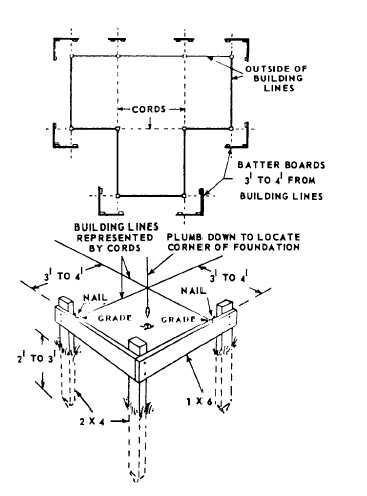from one line to another is to use a surveying instrument called a transit. However, if you do not have a transit, you can locate the corner points with tape measurements by applying the Pythagorean theorem. First, stretch a cord from monument A to monument B, and locate points C and D by tape measurements from A. Now, if you examine figure 5-16, you will observe that straight lines connecting points C, D, and E form a right triangle with one side 40 feet long and the adjacent side 35 feet long. By the Pythagorean theorem, the length of the hypotenuse of this triangle (the line ED) is equal the square root of 352 +402 , which is approximately 53.1 feet. Because figure EG DC is a rectangle, the diagonals both ways (ED and CG) are equal. Therefore, the line from C to G should also measure 53.1 feet. If you have one person hold the 53. 1-foot mark of a tape on D, have another hold the 35-foot mark of another tape on C, and have a third person walk away with the joined 0-foot ends, when the tapes come taut, the joined 0-foot ends will lie on the correct location for point E. The same procedure, but this time with the 53. 1-foot length of tape running from C and the 35-foot length ruining from D, will locate corner point G. Corner points F and H can be located by the same process, or by extending CE and DG 20 feet.
PERPENDICULAR BY 3:4:5 TRIANGLE
If you would rather avoid the square root calculations required in the Pythagorean theorem method, you can apply the basic fact that any triangle with sides in the proportions of 3:4:5 is a right triangle. In locating point E, you know that this point lies 35 feet from C on a line perpendicular to the base line. You also know that a triangle with sides 30 and 40 feet long and a hypotenuse 50 feet long is a right triangle.
To get the 40-foot side, you measure off 40 feet from C along the base line; in figure 5-16, the segment from C to D happens to measure 40 feet. Now, if you run a 50-foot tape from D and a 30-foot tape from C, the joined ends will lie on a line perpendicular from the base line, 30 feet from C. Drive a hub at this point, and extend the line to E (5 more feet) by stretching a cord from C across the mark on the hub.
BATTER BOARDS
Hubs driven at the exact locations of building corners will be disturbed as soon as the excavation for the foundation begins. To preserve the corner locations, and also to provide a reference for measurement down to the prescribed elevations, batter boards are erected as shown in figure 5-17.
Each pair of boards is nailed to three 2-by-4 corner stakes as shown. The stakes are driven far enough outside the building lines so that they will not be disturbed during excavation. The top edges of the boards are located at a specific elevation, usually some convenient number of whole feet above a significant prescribed elevation, such as that at the top of the foundation. Cords located directly over the lines through corner hubs, placed by holding plumb bobs on the hubs, are nailed to the batter boards. Figure 5-17 shows how a corner point can be located in the excavation by dropping a plumb bob from the point of intersection between two cords.

Figure 5-17. - Batter boards.
Continue Reading